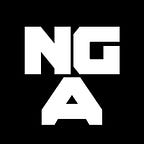Joseph Beuys was here, 1982
The National Gallery of Australia (NGA) acquired German Fluxus artist Joseph Beuys’ ‘Stripes from the house of the shaman 1964–72’ in 1981, and the next year, Beuys himself arrived in Australia to coordinate its first installation.
The story goes that in 1944, Joseph Beuys was a Luftwaffe gunner in the Second World War, and his plane crashed in frozen Crimean wastelands. Tartar rescuers saved his life by rubbing him with fat and wrapping him in felt — two materials that would become highly symbolic and ritualised in his future art practice. This experience was the foundation of Beuys’ self-styled shamanic persona and the impetus to his unorthodox and anarchic approach to art making.
By the 1980s, Joseph Beuys was a god.
Ben Taylor, artist and NGA Exhibitions Installer, recalls Beuys’ 1981 visit to the NGA in Canberra to install Stripes from the house of the shaman 1964–72, ‘He was an international art superstar and admired by all of us as a brilliant man — we were very excited.’
‘He seemed serious, and entered wearing his trademark hat and vest, accompanied by his assistant and interpreter,’ Ben remembers.
‘The NGA had tried to recreate the space where the work of art was originally displayed in its 1980 manifestation in the Anthony d’Offay Gallery, London — including a large door and wall mimicking one where the felt pieces had been strung between two rooms.
‘Beuys pondered the space awhile, and his assistant informed us that he didn’t like the recreation of the wall space, and that he would like to reconfigure the work to fit the surrounds. So he went away and the walls were pulled down.
‘Beuys asked NGA’s then-Head of Installations Joe Markac — a very talented carpenter — if he could build an arch of old timber using no nails. Beuys did a drawing of what he wanted — but who knows where it ended up.
‘At this time in Queanbeyan, there was a second-hand building materials junk yard called Quinlan and Kirk, run by a tough old Queanbeyan local. We took our international superstar, Beuys, to this yard in search of old timber to build his new arch.
‘Looking through the timber, Beuys rejected straight pieces of timber in favour of curved and bent pieces — he said the wood ‘remembers the tree’. This became Holy Scripture for generations of NGA installers.
‘Quinlan privately considered Beuys’ choice to be the worst of the timber in the yard, and was delighted to get twenty dollars for it, all the while unaware he was in the presence of art royalty and the destiny of the old hardwood planks.
‘Joe Markac built a beautiful arch for Beuys without nails, but with little wooden wedges to hold it together. This is the element we see in the work today, approved by Beuys as a new part of the work. Beuys was very pleased and quietly offered Joe a job as an assistant in Europe! Joe turned down the job in favour of staying in Canberra.
‘At the time, I was told to return to other duties elsewhere in the Gallery. I refused, knowing history was unfolding and wanting to take the opportunity to observe the great artist at work.
‘Beuys was very quiet, serious and still throughout, but spoke and worked through his assistant. He took great care directing us to make the lines in the felt strip that run through the arch and splay out on the floor appear smooth, straight and effortless as if they had rolled from the timber piece at the back of the work.
‘I remember Beuys expecting the public to walk around the elements of the installation rather than it being viewed at a distance.
‘At one stage, during installation, around ten people were needed to roll a piece of copper inside the longest strip of felt on the ground. Guided by Beuys and his assistant, it felt like a religious moment. He gave the order to roll, and we keenly began, but then to my mortification proceedings were quickly stopped and we were told to ‘Slow down!’ We unrolled and started again.
‘A nice touch at the end of the installation was Beuys placing a small tip of a dead tree branch just off the window frame, catching the daylight entering from the back of the gallery. It was a subtle inclusion — I think he smiled.
‘Inside the pocket of the coat hanging on the wall, there is a piece of paper with script on it. I was itching to know what it said. I had it translated out of curiosity — it was about free education.
‘Beuys’ wife and two teenage children joined him towards the end of the install. I caught his long haired son in John Lennon glasses admiring our forty-dollar black ripple sole desert boots — high couture in the 80s. For a minute while his family visited, Beuys stepped out of his haunting seriousness.’
Stripes from the house of the shaman 1964–72 is on display in the NGA’s International galleries, Level 2, alongside former NGA photographer Matt Kelso’s photographs of the first install in the NGA. FREE until 18 February 2019.
